Transfer MDaemon to Exchange 2007/2003 (P.1)
There are many methods to perform the transformation of MDaemon Mail Server to Exchange Server.
Network administration - There are many methods to perform the migration of MDaemon Mail Server to Exchange Server. These methods include: Single Step (called Big Bang Migration) and Coexistence.
Introduce
Any mail conversion process requires a lot of preparation, from the mail administrator to ensuring that all end-users and mail will not be affected during the conversion process.
This series of articles will focus on setting the minimum requirements for moving from third-party mail servers to Exchange Server 2003 and 2007. We will use MDaemon mail server as the source mail server for Exchange 2007 and Exchange 2003. However, we can use the same principles applied here for all other third-party mail servers.
There are many methods to perform the transformation of MDaemon Mail Server to Exchange Server. These methods include: Single Step (called Big Bang Migration) and Coexistence. The Big Bang Migration method means that all users will be migrated at the same time. Coexistence method means that both systems are installed and used, sharing information and only one user group is moved at a time. This method is more complex and requires more operations to ensure that both user groups (moving and not moving) can exchange information and use both mail systems during the conversion process. .
In order to make the transition successful, we will have to consider four important points for the Coexistence method, including: Directory Synchronization, Global Address List, Mail Routing and Data Migration Process. This general rule can be applied during Exchange conversion to provide basic functions while operating the two systems (Coexistence) but that is not a single rule, you can still add Add or remove other important parts in the conversion plan.
Microsoft provides a set of tools to help perform these tasks when the source systems used are Lotus Notes or GroupWise (Microsoft Lotus and GroupWise Connectors are integrated in Exchange Server 2003 and Microsoft Transporter for Lotus Notes in Exchange Server 2007). . However, no separate integration tool can perform all these tasks when the source system is a third-party mail server.
 Transfer MDaemon to Exchange 2007/2003 (P.1) Picture 1
Transfer MDaemon to Exchange 2007/2003 (P.1) Picture 1
The conversion process needs to perform many operations, but there are a number of important points we need to pay attention to before embarking on implementation, including:
In this series of articles we will perform the migration from Mdaemon mail server to Exchange Server 2007 and in the final part we will implement the same method to switch Exchange Server 2003 brightly.
First we will use 3 servers: Domain Controller server, Exchange Server 2007 server with 3 basic functions pre-installed (including Mailbox - mailbox, Client Access Server - Client access server, and Hub Transport - Hub Transport), and MDaemon mail server. This system is simulated by the following illustration:
 Transfer MDaemon to Exchange 2007/2003 (P.1) Picture 2
Transfer MDaemon to Exchange 2007/2003 (P.1) Picture 2
Active Directory is a single domain called apatricio.local and the SMTP address being used by MDaemon is andersonpatricio.org .
Verify directory permissions
Our goal is to ensure that the authentication folders are synchronized. MDaemon Mail Server allows you to use various methods to create mailboxes in the mail system and mailbox information can be stored in a regular disk file, ODBC data source or LDAP storage. We can also use Active Directory to import users or manage Active for user installations and then new users created in Active Directory can also be created in MDaemon.
Based on many methods of storing accounts and mailboxes, we must ensure that both directories (on two systems) are synchronized, or at least both of these folders must be shared by the same user. Here are some possible situations when ensuring the system after the conversion will add all user accounts to Active Directory.
Scenario 1: Active Directory and Mdeamon are being assimilated through MDaemon.
The best method you can do from the start of conversion is if Mdaemon uses Active Directory to synchronize mailboxes, we can check it by opening Mdaemon , going to Accounts menu, and accessing Account Database / Active Directory / Minger ., then select the Active Directory tab.
 Transfer MDaemon to Exchange 2007/2003 (P.1) Picture 3
Transfer MDaemon to Exchange 2007/2003 (P.1) Picture 3
If the first checkbox is enabled, any new Active Directory in Active Directory will automatically start a mailbox creation process and the password used will be the password of the two systems. The same process will be performed for deleted accounts. In our system, the mailbox will be canceled when the Active Directory account is deleted.
If you are selecting this option, go to the next step because you do not need to create users because MDaemon mailboxes are taken from Active Directory.
Scenario 2: Active Directory is incompatible.
In this situation we will have to make sure that all MDaemon users already have an account in Active Directory before converting their mail clients to the new system. In some cases, users may have two different directories, including Active Directory (where all users are logged with different usernames and passwords at the mail level). In this case the administrator will have to manage and instruct the user to use the same username and password to log into the network (Active Directory) and the mail (Exchange) system.
To export information from Mdaemon to Active Directory, follow these steps:
Note: The MDaemon dump process may contain passwords, which is useful because all new users in Active Directory will use their current passwords.
1. First, determine which usernames are currently being used on the MDaemon server. Open the MDaemon Console , click on Accounts and then access the Account Manager . We can reuse this step to remove unnecessary accounts from the source system.
 Transfer MDaemon to Exchange 2007/2003 (P.1) Picture 4
Transfer MDaemon to Exchange 2007/2003 (P.1) Picture 4
2. Now we can import existing accounts. Click on Accounts | Exporting then select the Export accounts to a comma delimited file .
3. Then a dialog box will appear indicating the dump will create a Accounts.csv file, and this file will be saved to the path C: MdaemonAPPAccounts.csv . Then click OK .
4. After the dumping process is complete, you will see a notification dialog. Click OK .
5. We can open the file created by MDaemon and a list of all users and their status.
 Transfer MDaemon to Exchange 2007/2003 (P.1) Picture 5
Transfer MDaemon to Exchange 2007/2003 (P.1) Picture 5
Note: We can also delete the Accounts.csv file to prevent unnecessary accounts from being moved. In this step we will remove the integrated administrator and MDaemon / administrator accounts / accounts from this csv file because they will not be migrated to Exchange Server .
Now we can copy file C: MDaemonAppAccounts.csv to the original Exchange Server drive . When logging in with the right to create an account and mailbox, you can run the following commands:
 Transfer MDaemon to Exchange 2007/2003 (P.1) Picture 6
Transfer MDaemon to Exchange 2007/2003 (P.1) Picture 6
Note: You may encounter problems with users whose passwords do not match Active Directory security requirements, and you can change the current Domain Policy configuration accordingly. new users.
If you are currently migrating from another system and you cannot retrieve the user's password, you can create a common password for new users.
Conclude
In this section, we have done the main tasks that need to be done during the transition with Coexistence between Exchange and any third-party mail server. Our main purpose in the first part of this series is to make sure both directories are synchronized. This synchronization process may be starting automatically or will require a process to import / export.
Introduce
Any mail conversion process requires a lot of preparation, from the mail administrator to ensuring that all end-users and mail will not be affected during the conversion process.
This series of articles will focus on setting the minimum requirements for moving from third-party mail servers to Exchange Server 2003 and 2007. We will use MDaemon mail server as the source mail server for Exchange 2007 and Exchange 2003. However, we can use the same principles applied here for all other third-party mail servers.
There are many methods to perform the transformation of MDaemon Mail Server to Exchange Server. These methods include: Single Step (called Big Bang Migration) and Coexistence. The Big Bang Migration method means that all users will be migrated at the same time. Coexistence method means that both systems are installed and used, sharing information and only one user group is moved at a time. This method is more complex and requires more operations to ensure that both user groups (moving and not moving) can exchange information and use both mail systems during the conversion process. .
In order to make the transition successful, we will have to consider four important points for the Coexistence method, including: Directory Synchronization, Global Address List, Mail Routing and Data Migration Process. This general rule can be applied during Exchange conversion to provide basic functions while operating the two systems (Coexistence) but that is not a single rule, you can still add Add or remove other important parts in the conversion plan.
Microsoft provides a set of tools to help perform these tasks when the source systems used are Lotus Notes or GroupWise (Microsoft Lotus and GroupWise Connectors are integrated in Exchange Server 2003 and Microsoft Transporter for Lotus Notes in Exchange Server 2007). . However, no separate integration tool can perform all these tasks when the source system is a third-party mail server.
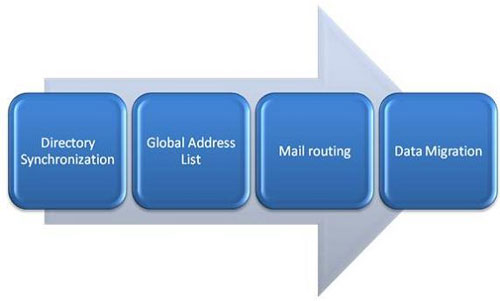 Transfer MDaemon to Exchange 2007/2003 (P.1) Picture 1
Transfer MDaemon to Exchange 2007/2003 (P.1) Picture 1 The conversion process needs to perform many operations, but there are a number of important points we need to pay attention to before embarking on implementation, including:
- Backup
- Ability to exchange information before, during and after conversion.
- Antivirus
- Secondary drive system
- Data
- Applications that forward on mail servers
- User guide
- IT group training
- Deploy Outlook
- Use Outlook Web Access for new users
- Mail compression
In this series of articles we will perform the migration from Mdaemon mail server to Exchange Server 2007 and in the final part we will implement the same method to switch Exchange Server 2003 brightly.
First we will use 3 servers: Domain Controller server, Exchange Server 2007 server with 3 basic functions pre-installed (including Mailbox - mailbox, Client Access Server - Client access server, and Hub Transport - Hub Transport), and MDaemon mail server. This system is simulated by the following illustration:
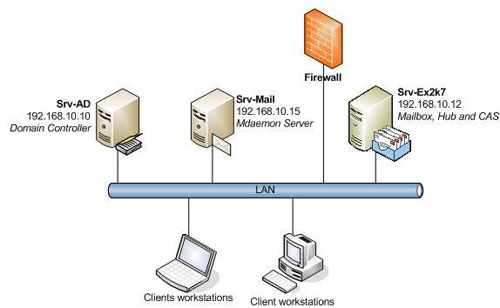 Transfer MDaemon to Exchange 2007/2003 (P.1) Picture 2
Transfer MDaemon to Exchange 2007/2003 (P.1) Picture 2 Active Directory is a single domain called apatricio.local and the SMTP address being used by MDaemon is andersonpatricio.org .
Verify directory permissions
Our goal is to ensure that the authentication folders are synchronized. MDaemon Mail Server allows you to use various methods to create mailboxes in the mail system and mailbox information can be stored in a regular disk file, ODBC data source or LDAP storage. We can also use Active Directory to import users or manage Active for user installations and then new users created in Active Directory can also be created in MDaemon.
Based on many methods of storing accounts and mailboxes, we must ensure that both directories (on two systems) are synchronized, or at least both of these folders must be shared by the same user. Here are some possible situations when ensuring the system after the conversion will add all user accounts to Active Directory.
Scenario 1: Active Directory and Mdeamon are being assimilated through MDaemon.
The best method you can do from the start of conversion is if Mdaemon uses Active Directory to synchronize mailboxes, we can check it by opening Mdaemon , going to Accounts menu, and accessing Account Database / Active Directory / Minger ., then select the Active Directory tab.
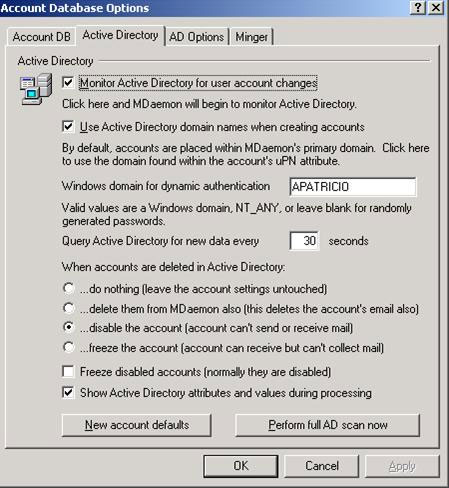 Transfer MDaemon to Exchange 2007/2003 (P.1) Picture 3
Transfer MDaemon to Exchange 2007/2003 (P.1) Picture 3 If the first checkbox is enabled, any new Active Directory in Active Directory will automatically start a mailbox creation process and the password used will be the password of the two systems. The same process will be performed for deleted accounts. In our system, the mailbox will be canceled when the Active Directory account is deleted.
If you are selecting this option, go to the next step because you do not need to create users because MDaemon mailboxes are taken from Active Directory.
Scenario 2: Active Directory is incompatible.
In this situation we will have to make sure that all MDaemon users already have an account in Active Directory before converting their mail clients to the new system. In some cases, users may have two different directories, including Active Directory (where all users are logged with different usernames and passwords at the mail level). In this case the administrator will have to manage and instruct the user to use the same username and password to log into the network (Active Directory) and the mail (Exchange) system.
To export information from Mdaemon to Active Directory, follow these steps:
Note: The MDaemon dump process may contain passwords, which is useful because all new users in Active Directory will use their current passwords.
1. First, determine which usernames are currently being used on the MDaemon server. Open the MDaemon Console , click on Accounts and then access the Account Manager . We can reuse this step to remove unnecessary accounts from the source system.
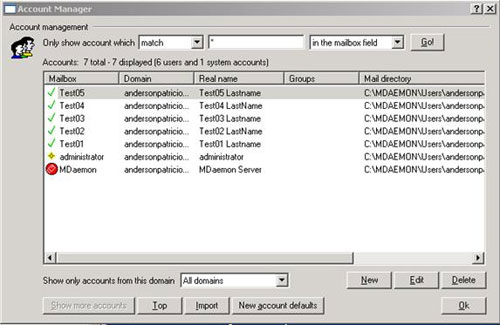 Transfer MDaemon to Exchange 2007/2003 (P.1) Picture 4
Transfer MDaemon to Exchange 2007/2003 (P.1) Picture 4 2. Now we can import existing accounts. Click on Accounts | Exporting then select the Export accounts to a comma delimited file .
3. Then a dialog box will appear indicating the dump will create a Accounts.csv file, and this file will be saved to the path C: MdaemonAPPAccounts.csv . Then click OK .
4. After the dumping process is complete, you will see a notification dialog. Click OK .
5. We can open the file created by MDaemon and a list of all users and their status.
 Transfer MDaemon to Exchange 2007/2003 (P.1) Picture 5
Transfer MDaemon to Exchange 2007/2003 (P.1) Picture 5 Note: We can also delete the Accounts.csv file to prevent unnecessary accounts from being moved. In this step we will remove the integrated administrator and MDaemon / administrator accounts / accounts from this csv file because they will not be migrated to Exchange Server .
Now we can copy file C: MDaemonAppAccounts.csv to the original Exchange Server drive . When logging in with the right to create an account and mailbox, you can run the following commands:
$ Users = Import-CSV C: Accounts.csv
$ Users | ForEach {$ SecurePWD = ConvertTo-SecureString $ _. Password --AsPlainText –Force; New-MailUser –Name $ _. Mailbox –UserPrincipalName ($ _. Mailbox + '@') –SamAccountName $ _. Mailbox –FirstName $ _. FullName –Password $ SecurePWD –ResetPasswordOnNextLogon $ false –ExternalEmailAddress ('SMTP:' + $ _ .Email)}
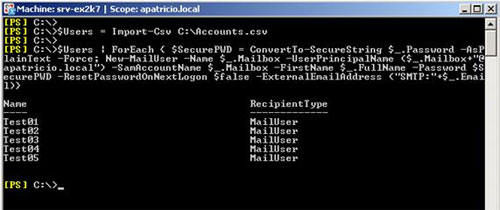 Transfer MDaemon to Exchange 2007/2003 (P.1) Picture 6
Transfer MDaemon to Exchange 2007/2003 (P.1) Picture 6 Note: You may encounter problems with users whose passwords do not match Active Directory security requirements, and you can change the current Domain Policy configuration accordingly. new users.
If you are currently migrating from another system and you cannot retrieve the user's password, you can create a common password for new users.
Conclude
In this section, we have done the main tasks that need to be done during the transition with Coexistence between Exchange and any third-party mail server. Our main purpose in the first part of this series is to make sure both directories are synchronized. This synchronization process may be starting automatically or will require a process to import / export.
3.7 ★ | 3 Vote
You should read it
- Transfer MDaemon to Exchange 2007/2003 (Part 2)
- Transfer MDaemon to Exchange 2007/2003 (P.7)
- Transfer MDaemon to Exchange 2007/2003 (P.3)
- Transfer MDaemon to Exchange 2007/2003 (P.5)
- Transfer MDaemon to Exchange 2007/2003 (P.4)
- Transfer MDaemon to Exchange 2007/2003 (P.6)
- Instructions for installing MDaemon Mail Server
- Enterprise e-mail management with Exchange Server 2010
- Transfer from Linux Mail Server to Exchange Server 2007 (Part 1)
- Introducing Exchange Server 2019, how to install Exchange Server 2019
- Limit sending and receiving mail in Exchange 2007
- Use remote connection analysis tool for Exchange Server - Part 1






 Transfer MDaemon to Exchange 2007/2003 (Part 2)
Transfer MDaemon to Exchange 2007/2003 (Part 2) Transfer MDaemon to Exchange 2007/2003 (P.7)
Transfer MDaemon to Exchange 2007/2003 (P.7) Transfer MDaemon to Exchange 2007/2003 (P.5)
Transfer MDaemon to Exchange 2007/2003 (P.5) Transfer MDaemon to Exchange 2007/2003 (P.4)
Transfer MDaemon to Exchange 2007/2003 (P.4) Transfer MDaemon to Exchange 2007/2003 (P.6)
Transfer MDaemon to Exchange 2007/2003 (P.6) Transfer MDaemon to Exchange 2007/2003 (P.3)
Transfer MDaemon to Exchange 2007/2003 (P.3)